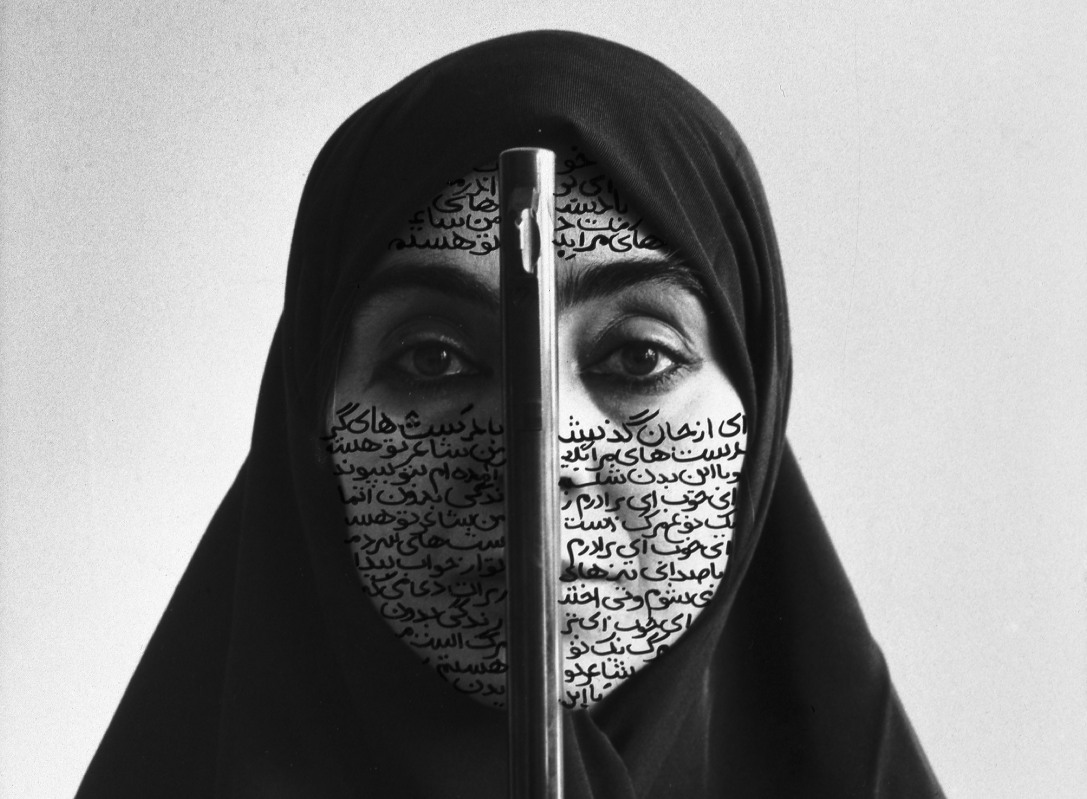b. 1957
Shirin Neshat, the best known artist in the Iranian diaspora, is a photographer and film-maker, who lives in New York City. Neshat has used Persian poetry and calligraphy in her works to examine concepts of martyrdom, exile, and feminism in the Muslim world.
Neshat was studying art in California at U.C. Berkeley when the Iranian revolution took place in 1979. She wouldn’t see her family again for more than 11 years. Returning to Iran in 1990, Neshat was shocked by the transformation caused by Islamic fundamentalism, especially the requiring of women to wear the chador in public. Upon her return to the United States, the black chador became a central motif in her work.
The condition of women in the Muslim world – especially in Iran – are dominant in her work. Neshat’s black-and-white photographic series “Women of Allah” 1993-1997, her first significant body of work, addresses the role of militant Muslim women, who fought in the 1979 revolution that overthrew the Shah. Many of her pictures here are self-portraits. She credits the self-portrait paintings of Mexican artist Friday Kahlo as inspiration for her “Women of Allah.” Neshat shows herself in traditional dress, posed with a rifle or handgun. Her exposed skin is covered in delicate Farsi and Arabic writing.
She shows armed Islamic women clothed in full-length chadors. Calligraphic poems by Iranian poets are written on the surfaces of the images. Her gelatin-silver print of “Rebellious Silence” 1994 makes dramatic use of the chador to isolate her subject’s face. The uncovered part of the face is written on with Farsi texts, written by Iranian female poets.
Neshat’s video art installations often takes the form of double projections to show the separation of public and private space with a viewer placed between two screens. In her 1998 “Turbulent,” screens are mounted on opposite walls. One screen shows a man on a stage singing before an all-male audience. The other screen shows a woman seen from behind singing before an empty theater. The camera on the man is static, while on the woman it circles her, and the viewer of the video becomes her audience. In the end, only the voice of the woman is heard.
Time and history infiltrate her art as can be seen in black-and-white photos from her series “The Book of Kings,” in which she superimposes line-drawings from historical lithographs, illustrating the epic poem the”Shahnama” onto the legs or torsos of anonymous men. In one photograph “Divine Rebellion” a pair of legs, shown from the toes to just before the knees, fills the frame. Drawn on them are pictures from the “Shahnama” of fighting medieval warriors. Red blood gushes from a black-and-white warrior’s torso. There is haunted ambiguity in the placement of the legs, which could be taking a step forward or could be dangling in space as if from a hanged body.
During 2020, Neshat decided to turn her lens from Middle Eastern countries to America to capture images of Americans and to show an immigrant’s perspective about this country. She traveled in the Navajo Nation in New Mexico and focused on Native Americans who have been treated poorly. As an immigrant she wanted to go into the center of America and document the anxiety that people share. There she finished her recent video work during the pandemic, a surreal tale entitled “Land of Dreams.” This work veers towards magical realism as she portrays dreams that have references to reality.
Neshat has won numerous awards, including an international award at the Venice Biennale in 1999 and an award for best director at the 2009 Venice Film Festival. In 2016, she was awarded a U.S.A. Rockefeller Fellow. Neshat’s tattoo photographs were exhibited in the Los Angeles County Museum of Art’s comprehensive exhibiton of Iranian art, “In the Fields of Empty Days.” A career retrospective,”I Will Greet the Sun Again,” is being exhibited at the Broad Museum, Los Angeles, in October, 2019.
More here.
